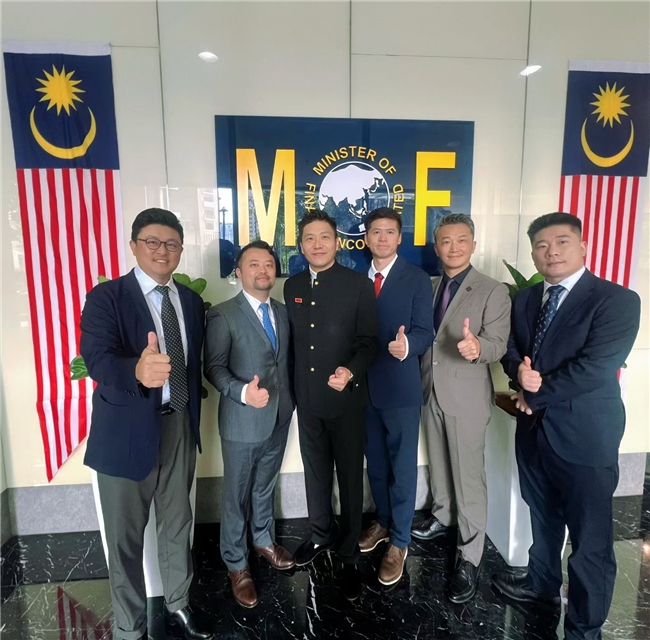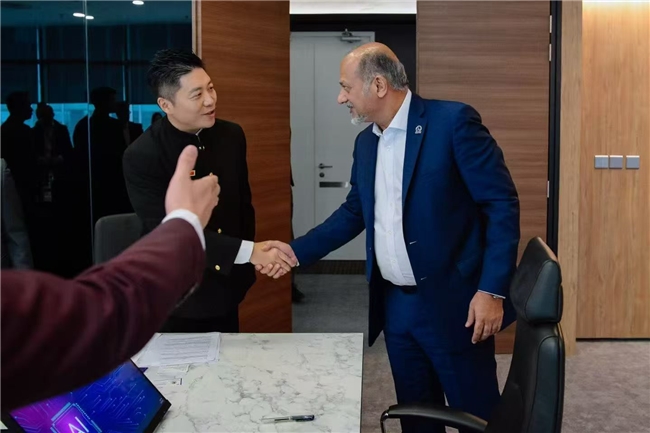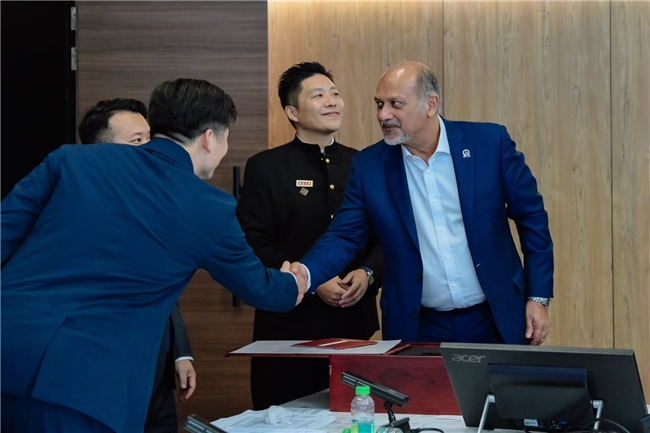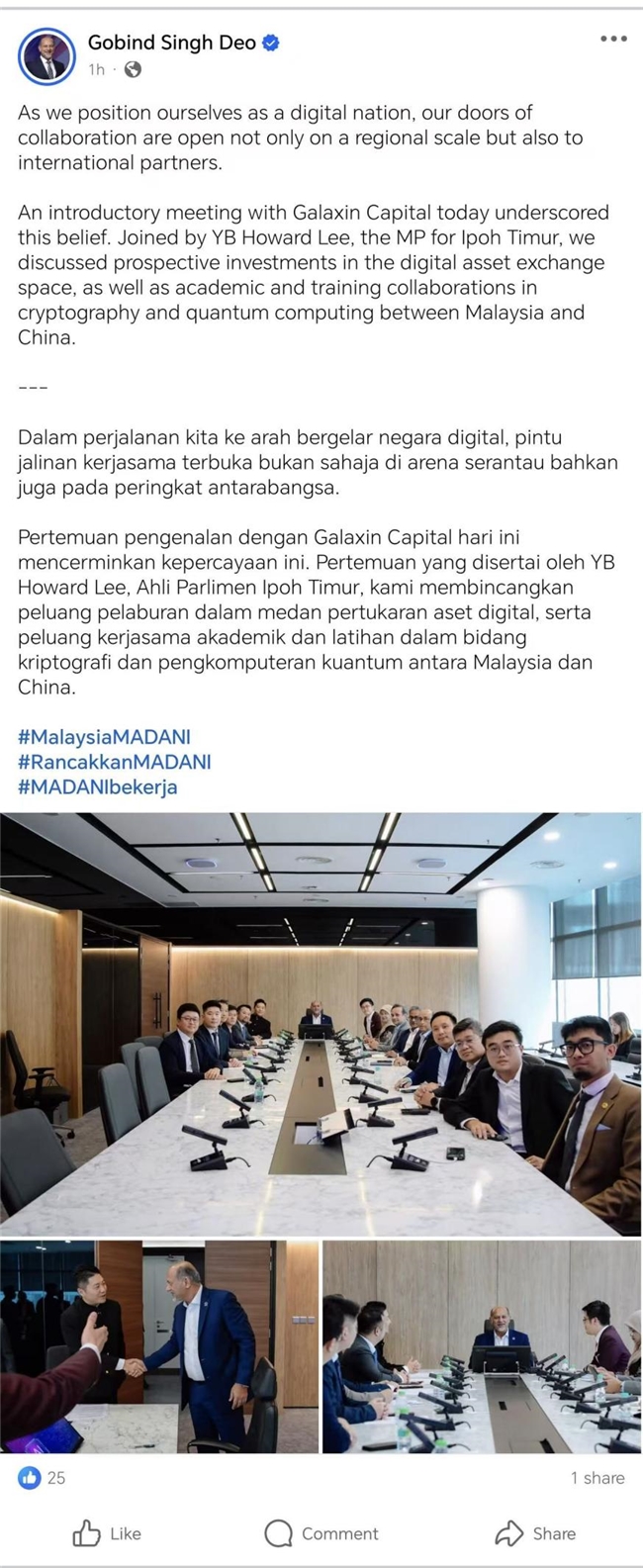As the digital wave meets the cultural legacy of the Silk Road across time and space, an in-depth dialogue on future development is unfolding with vibrant momentum.
Recently, a Chinese digital finance delegation led by Dr. Mo Yi—Council Member of Peking University's Strategic Research Institute, Head of the Digital Finance Research Group, and Chief Expert—along with institutions including Galaxin Capital and Buffalo Capital, was invited to visit Malaysia. The delegation held formal meetings with Malaysian dignitaries, including Digital Minister Gobind Singh Deo, at the Finance Building in Kuala Lumpur. During the talks, both sides engaged in detailed discussions on digital infrastructure development and explored forward-looking concepts for financial innovation, opening up new avenues for future digital cooperation between China and Malaysia.

Caption: (From left to right) Gao Yongfeng, Founder of Buffalo Capital; Deng Zhi, CEO and Co-founder of Galaxin Capital; Dr. Mo Yi, Council Member of the Institute for Strategic Studies at Peking University, Head and Chief Expert of its Digital Finance Research Group; YB Gobind Singh Deo, Chairman of the Democratic Action Party (DAP), the leading party in Malaysia’s ruling coalition, and Minister of Digital; Howard Lee Chuan How, Member of Parliament for Ipoh Timur and “Friend of the Ministry of Digital”; and Wei Bo, Executive Director and Managing Partner of Galaxin Capital (Guangxi Region).
I. Digital Technology: A Global Wave of Economic Transformation
In today's world, the digital revolution is surging forward with tremendous momentum. The digital economy has become a central driving force behind economic growth and a key factor in enhancing international competitiveness across nations. It is reshaping the allocation of global resources, redefining the global economic landscape, and fundamentally transforming the dynamics of global competition.
In recent years, China and Malaysia have continuously nurtured new growth areas in digital cooperation, with the scope of collaboration in the digital industry steadily expanding to bring tangible benefits to the daily lives and livelihoods of both peoples. The release of the 2025 Joint Statement between the People’s Republic of China and Malaysia on Building a High-Level Strategic Community with a Shared Future has further positioned the digital economy as a key focus of future bilateral cooperation. This latest digital cooperation forum serves as a concrete manifestation of the deepening collaboration between the two countries in the digital domain.

II. Deepening Exchange: A New Opportunity for Digital Cooperation
Amid the global wave of digital economic development, China–Malaysia digital cooperation is entering a pivotal phase. During the meeting, YB Gobind Singh Deo, Malaysian Minister of Digital, not only warmly welcomed deeper exchanges between the two countries in the digital sphere but also publicly communicated Malaysia’s commitment to building a digital nation via social media—a clear signal of openness. This stance reflects both an active response to regional collaboration and strong expectations for the China–Malaysia digital partnership.
He has emphasized on multiple occasions that Southeast Asia, with its young population, high mobile penetration, and rapidly expanding e-commerce and digital services markets, is emerging as a key engine for global user growth. He also underscored that realizing the full potential of this market depends on the collaborative support of core partners such as China. Malaysia will continue to pursue digital development with an open and inclusive mindset, with cooperation with China serving as a central pillar of its “Shared Inclusive Growth” strategy.

III. Joint Consultation and Construction: Broad Prospects for China-Malaysia Cooperation
Howard Lee, Member of Parliament for Ipoh Timur, Malaysia; Deng Zhi, CEO and Co-founder of Galaxin Capital; Wei Bo, Executive Director and Managing Partner of Galaxin Capital (Guangxi Region); Gao Yongfeng, Founder of Buffalo Capital; and Wu Jin, Co-founder of Buffalo Capital, attended the meeting. Participants emphasized that China, while advancing its own digital development, maintains an open stance and actively seeks collaboration with regional and international partners. The meeting centered on in-depth discussions of investment opportunities in the digital asset trading sector. The parties conducted a comprehensive assessment of market prospects, carefully identified potential risks, and explored points of synergy through candid dialogue. This practice of “consultation and co-construction” charts new paths for the standardized development of regional digital asset markets, gradually turning the vision of mutually beneficial cooperation into reality.
Notably, the scope of cooperation is extending further into advanced technological areas. Both sides engaged in in-depth discussions on academic exchanges and training collaborations between Malaysia and China in cryptography and quantum computing. As critical levers for strengthening information security and driving technological innovation in the digital era, breakthroughs in these fields directly underpin the security and innovation foundations of the digital economy. Enhancing bilateral cooperation in these frontier areas is not only a pragmatic strategy for improving both countries’ technical problem-solving capabilities and original innovation through intellectual exchange and resource sharing, but also a strategic initiative to establish technological “moats” and consolidate foundational support for the sustainable development of the regional digital economy. This collaboration lays a dual foundation of technology and trust, providing a robust base for broader digital cooperation across diverse domains.

IV. Historical Perspective: A Longstanding China–Malaysia Partnership
As key drivers of development in the Asia–Pacific region and active proponents of Global South cooperation, the two countries have consistently moved in alignment amid changes in the international order. They steadfastly safeguard the common interests of developing nations on multilateral platforms, forging a strategic rapport grounded in shared destiny.
Since the establishment of diplomatic relations in 1974, which laid the foundation of mutual trust, through the 2013 Comprehensive Strategic Partnership that revitalized bilateral cooperation, to the 2023 consensus reached by both leaders on building a high-level China–Malaysia Strategic Community with a Shared Future, and the 2025 Declaration on the Strategic Community with a Shared Future, which anchors the future trajectory, China–Malaysia relations have steadily progressed in step with the times. Today, the Digital Silk Road and Malaysia’s Digital Economy Blueprint are closely aligned, with continuous achievements in digital infrastructure connectivity and cross-border digital governance. These developments not only infuses new meaning into bilateral cooperation in the digital age but also provides valuable insights for regional digital economic development through pragmatic cooperation models.
Against the backdrop of the “China-Malaysia Community with a Shared Future” and “Digital China,” China has been Malaysia's largest trading partner for 16 consecutive years. The strong foundation of bilateral economic and trade cooperation provides broad opportunities for Chinese private enterprises to expand into the Malaysian market.
Gao Yongfeng, founder of Buffalo Capital, expressed his hope that more outstanding Chinese private enterprises will establish a presence in Malaysia and achieve new growth in the fertile ground of bilateral cooperation.

V. Strategic Layout: Launching the Digital Development Engine
Digital technology acts as an invisible thread, linking opportunities for growth. Following the development pathway outlined by the shared community, China’s core strengths in cryptography and the digital economy, along with the research capabilities of its leading academic institutions, can be harnessed to generate powerful regional synergy. R&D in Beijing, Shanghai, and Guangzhou lays a solid technological foundation; integration in Guangxi establishes key gateway hubs; and ASEAN applications unlock new market opportunities. This three-dimensional coordination forms a closed-loop ecosystem for the digital economy.
Today, this strategic layout has assumed significant importance. The establishment of the China–ASEAN Innovation Cooperation Center will break down geographical and industrial barriers, while the development of the ASEAN Corpus will remove linguistic obstacles for AI deployment, enabling digital technology to serve as a true “golden key” empowering industries across ASEAN. Guangxi’s gateway advantage complements Guangdong’s industrial and investment strength: the former reinforces the foundations of cooperation through industry–academia–research collaboration, while the latter expands the scope of partnership through new productive forces. Driven by this dual-engine approach, China–Malaysia digital cooperation is moving from project-level synergy toward ecosystem co-creation, injecting a powerful digital-era engine into the region’s high-quality development.
VI. Looking ahead, boundless potential for diversified cooperation.
As a significant milestone in the journey of China-Malaysia digital cooperation, this conference underscores the commitment and resolve of all parties to advance digital development. Participants view it as a starting point to continuously expand the scope of cooperation, deepen synergies, and comprehensively promote alignment of development strategies and the deep integration of industrial and supply chains. On the new path toward building a high-quality community, the digital economy clarifies cooperation channels and streamlines the flow of resources, ultimately enabling the two nations to move forward hand in hand, advancing further together amid the tides of the times!
South–South solidarity, a rising tide of digital intelligence. Under an open and inclusive framework of cooperation, China’s digital technologies and expertise will continue to traverse oceans alongside the ongoing economic and trade exchanges between China and Malaysia, writing a new chapter in their millennia-old friendship in the digital age!

